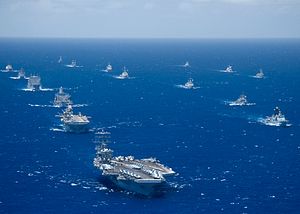Four Chinese ships set sail on Monday, on their way to take part in the Hawaii-based RIMPAC international maritime exercise. This year’s RIMPAC will feature participants from 23 nations, with China joining for the very first time. According to Chinese media reports, China will be represented at RIMPAC by the Haikou (a missile destroyer), the Yueyang (a missile frigate), the Qiandaohu (a supply ship), and the Peace Ark (a hospital ship). 1,100 Chinese officers and soldiers will take part in the drill, including a diving squad and a commando unit.
RIMPAC, the largest joint maritime exercise in the world, is hosted every two years by the U.S. Pacific Fleet. This year’s exercises are scheduled to last from June 26 to August 1. The exercise is officially described as “a unique training opportunity that helps participants foster and sustain the cooperative relationships that are critical to ensuring the safety of sea lanes and security on the world’s oceans.” Exercises during RIMPAC will touch on a variety of capabilities, including disaster relief, counter-piracy operations, mine clearing operations, and anti-submarine and air defense exercises.
At the last RIMPAC exercise in 2012, China was upset by the fact that Russia and India participated for the first time, but Beijing did not merit an invitation (India did not end up sending a ship, but was represented by command staff). Chinese media denounced RIMPAC as an attempt to contain China’s rise by forging U.S. military relationship with other Asia-Pacific nations.
Now that its own ships are on the way to RIMPAC 2014, China is viewing the joint exercises as a positive step toward cooperation rather than a move toward containment. Xinhua called China’s participation in RIMPAC 2014 “a positive signal for building trust between China and the United States.” U.S.-China cooperation will extend beyond the RIMPAC exercise itself — Global Times reports that three of the four Chinese vessels (all but the hospital ship Peace Ark) will stop in San Diego for a port visit after RIMPAC concludes. In the context of other joint military exercises in the Pacific and the Gulf of Aden, Xinhua sees RIMPAC a continuation of “positive momentum” in mil-to-mil relations. Another Xinhua article heralded the departure of China’s RIMPAC contingent as a potentially “historic moment,” both for U.S.-China cooperation and for China’s military itself.
Xinhua also held out hope that the multinational exercise would help improve China’s relations not just with their American hosts, but with other participating countries as well, including Singapore and Brunei. “The exercise demonstrates China’s initiative in contributing to regional security,” Xinhua said. Ships from Singapore, Brunei, and China are scheduled to meet up with U.S. vessels near Guam before sailing together to Hawaii. Notably, Xinhua did not mention the potential for closer ties with Japan, even though Tokyo plays a major role at RIMPAC. Japanese Rear Admiral Yasuki Nakahata will serve as vice commander of RIMPAC 2014.
China’s participation in RIMPAC 2014 is unlikely to reverse the mutual distrust that has long been growing between China and the U.S. However, China attending this year’s exercise is far better than the alternative — another hard-to-defend snub from the U.S. In that case, Chinese media this week would have been full of articles denouncing RIMPAC and U.S. “containment” strategies rather than articles expressing optimism about the direction of China-U.S. ties. RIMPAC may be largely a symbolic exercise, but even in the military realm symbolism matters.

































